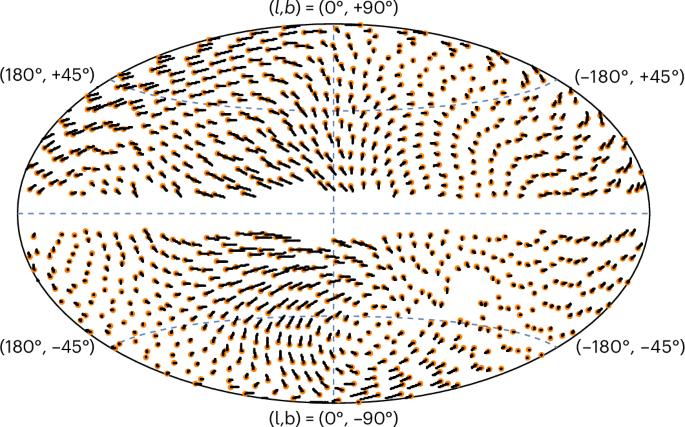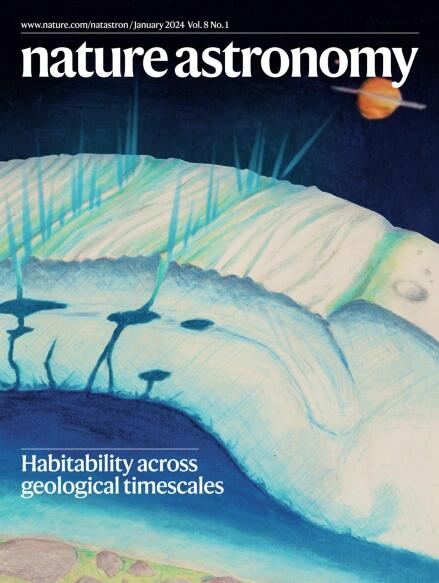从类星体固有运动观察到的高红移宇宙的运动学畸变
IF 14.3
1区 物理与天体物理
Q1 ASTRONOMY & ASTROPHYSICS
引用次数: 0
摘要
光学天体测量学的进步使我们能够直接从观测中推断出宇宙的非径向运动结构。在这里,我使用监督机器学习神经网络方法来预测157万红移,该方法基于来自不明智中红外数据库和盖亚的几个光度和元数据分类器参数。这些估计用于将样本分为三个红移箱:1-2、2-3和>;3。对于每个子集,所有可用的Gaia固有运动都用于3度(30次拟合向量函数)的全局矢量球谐解中。我发现在不同红移处,一些合适的运动模式存在显著差异。在1-2和2-3红移箱的矢量球谐拟合的比较中可以看到最大的信号。重要的谐波包括一个刚性自旋,一个偶极子从银河北极滑到南极,以及一个额外的四极子扭曲。滤波后的子样本验证试验表明,探测效应可能是由天体测量中隐藏的系统误差引起的。通过使用独立的红移源和计算观测者的星系中心加速度来验证结果。这项研究为其他宇宙学模型提供了一种新的观测测试。本文章由计算机程序翻译,如有差异,请以英文原文为准。


Kinematic distortions of the high-redshift Universe as seen from quasar proper motions
Advances in optical astrometry allow us to infer the non-radial kinematic structure of the Universe directly from observations. Here I use a supervised machine learning neural network method to predict 1.57 million redshifts based on several photometric and metadata classifier parameters from the unWISE mid-infrared database and from Gaia. These estimates are used to divide the sample into three redshift bins: 1–2, 2–3 and >3. For each subset, all available Gaia proper motions are used in a global vector spherical harmonic solution to degree 3 (30 fitting vector functions). I find significant differences in a few fitted proper motion patterns at different redshifts. The largest signals are seen in the comparison of the vector spherical harmonic fits for the 1–2 and 2–3 redshift bins. The significant harmonics include a rigid spin, a dipole glide from the north Galactic pole to the south and an additional quadrupole distortion. Validation tests with filtered subsamples indicate that the detected effect can be caused by hidden systematic errors in astrometry. The results are verified by using an independent source of redshifts and computing the observer’s Galactocentric acceleration. This study offers a new observational test of alternative cosmological models. Supervised machine learning predicts 1.57 million quasar redshifts from Gaia Data Release 3 photometry and astrometry, providing a new observational test of the cosmological principle.
求助全文
通过发布文献求助,成功后即可免费获取论文全文。
去求助
来源期刊

Nature Astronomy
Physics and Astronomy-Astronomy and Astrophysics
CiteScore
19.50
自引率
2.80%
发文量
252
期刊介绍:
Nature Astronomy, the oldest science, has played a significant role in the history of Nature. Throughout the years, pioneering discoveries such as the first quasar, exoplanet, and understanding of spiral nebulae have been reported in the journal. With the introduction of Nature Astronomy, the field now receives expanded coverage, welcoming research in astronomy, astrophysics, and planetary science. The primary objective is to encourage closer collaboration among researchers in these related areas.
Similar to other journals under the Nature brand, Nature Astronomy boasts a devoted team of professional editors, ensuring fairness and rigorous peer-review processes. The journal maintains high standards in copy-editing and production, ensuring timely publication and editorial independence.
In addition to original research, Nature Astronomy publishes a wide range of content, including Comments, Reviews, News and Views, Features, and Correspondence. This diverse collection covers various disciplines within astronomy and includes contributions from a diverse range of voices.
 求助内容:
求助内容: 应助结果提醒方式:
应助结果提醒方式:


